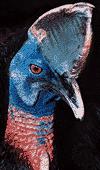- cassowary
-
/kas"euh wer'ee/, n., pl. cassowaries.any of several large flightless, ratite birds of the genus Casuarius, of Australia, New Guinea, and adjacent islands, characterized by a bony casque on the front of the head.[1605-15; by uncert. mediation < Central Moluccan kasuwari, kasuwali]
* * *
Related to the emu, it has been known to kill humans with slashing blows of its feet, which have long, daggerlike claws on the innermost toe. It has a featherless blue head protected by a bony crest and has a black body (immature birds are brownish). It moves rapidly along narrow tracks in the bush. Cassowaries eat fruit and small animals. The largest species is the common, or southern, cassowary(Casuarius casuarius), which stands almost 5 ft (1.5 m) tall. Common, or southern, cassowary (Casuarius casuarius).Anthony Mercieca from Root Resources
Common, or southern, cassowary (Casuarius casuarius).Anthony Mercieca from Root Resources* * *
▪ bird(genus Casuarius)any of several species of large flightless birds of the Australo-Papuan region. Cassowaries are the only members of the family Casuariidae and belong to the order Casuariiformes, which also includes the emu. The cassowary has been known to kill humans with slashing blows of its feet: the innermost of its three toes bears a long, daggerlike nail. The bird moves rapidly along narrow tracks in the bush, its naked blue head protected by a bony helmet, or casque. The body is black in adults, brownish in immature birds. The female lays three to six green eggs, each of which is about 13 cm (5 inches) long and weighs 650 g (23 ounces). The male incubates these for about 50 days in a leafy nest on the ground and may also provide most of the early care of the striped young. Cassowaries forage for fruits and small animals. There are three species (counted by some experts as six), each with several races. The common, or southern, cassowary, Casuarius casuarius (see photograph—>), which inhabits New Guinea, nearby islands, and Australia, is the largest—almost 1.5 m (5 feet) tall—and has two long, red wattles on the throat.* * *
Universalium. 2010.
